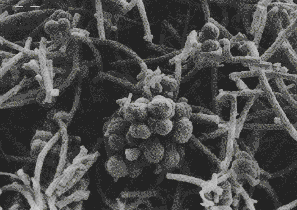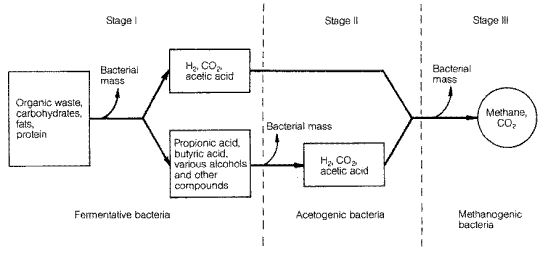Knowledge fuels change - Support energypedia!
For over 10 years, energypedia has been connecting energy experts around the world — helping them share knowledge, learn from each other, and accelerate the global energy transition.
Today, we ask for your support to keep this platform free and accessible to all.
Even a small contribution makes a big difference! If just 10–20% of our 60,000+ monthly visitors donated the equivalent of a cup of coffee — €5 — Energypedia would be fully funded for a whole year.
Is the knowledge you’ve gained through Energypedia this year worth €5 or more?
Your donation keeps the platform running, helps us create new knowledge products, and contributes directly to achieving SDG 7.
Thank you for your support, your donation, big or small, truly matters!
Biogas Basics
Overview
Biogas typically refers to a gas produced by the anaerobic digestion of organic matter including manure, sewage sludge, municipal solid waste, biodegradable waste or any other biodegradable feedstock, under anaerobic conditions. Biogas is comprised primarily of methane and carbon dioxide. It also contains smaller amounts of hydrogen sulphide, nitrogen, hydrogen, methylmercaptans and oxygen[1].
Biogas originates from bacteria in the process of bio-degradation of organic material under anaerobic (without air) conditions. The natural generation of biogas is an important part of the biogeochemical carbon cycle. Methanogens (methane producing bacteria) are the last link in a chain of micro-organisms which degrade organic material and return the decomposition products to the environment. In this process biogas is generated, a source of renewable energy.
The gases methane, hydrogen and carbon monoxide can be combusted or oxidized with oxygen. Air contains 21% oxygen. This energy release allows biogas to be used as a fuel. Biogas can be used as a low-cost fuel in any country for any heating purpose, such as cooking. It can also be utilized in modern waste management facilities where it can be used to run any type of heat engine, to generate either mechanical or electrical power. Biogas is a renewable fuel and electricity produced from it can be used to attract renewable energy subsidies in some parts of the world.
Below is the biogas equivalent to different fuels[2]:
- 1 Kg firewood => 0.2 m³ biogas
- 1 Kg dried cow dung => 0.1 m³ biogas
- 1 Kg Charcoal => 0.5 m³ biogas
- 1 Litre Kerosine => 2.0 m³ biogas
Anaerobic Fermentation
Knowledge of the fundamental processes involved in methane fermentation is necessary for planning, building and operating biogas plants. Anaerobic fermentation involves the activities of three different bacterial communities. The process of biogas-production depends on various parameters. For example, changes in ambient temperature can have a negative effect on bacterial activity.
Biogas microbes consist of a large group of complex and differently acting microbe species, notably the methane-producing bacteria. The whole biogas-process can be divided into three steps: hydrolysis, acidification, and methane formation. Three types of bacteria are involved.
| The three-stage anaerobic fermentation of biomass[3] |
Hydrolysis
In the first step (hydrolysis), the organic matter is enzymolyzed externally by extracellular enzymes (cellulase, amylase, protease and lipase) of microorganisms. Bacteria decompose the long chains of the complex carbohydrates, proteins and lipids into shorter parts. For example, polysaccharides are converted into monosaccharides. Proteins are split into peptides and amino acids.
Acidification
Acid-producing bacteria, involved in the second step, convert the intermediates of fermenting bacteria into acetic acid (CH3COOH), hydrogen (H2) and carbon dioxide (CO2). These bacteria are facultatively anaerobic and can grow under acid conditions. To produce acetic acid, they need oxygen and carbon. For this, they use the oxygen solved in the solution or bounded-oxygen. Hereby, the acid-producing bacteria create an anaerobic condition which is essential for the methane producing microorganisms. Moreover, they reduce the compounds with a low molecular weight into alcohols, organic acids, amino acids, carbon dioxide, hydrogen sulphide and traces of methane. From a chemical standpoint, this process is partially endergonic (i.e. only possible with energy input), since bacteria alone are not capable of sustaining that type of reaction.
Methanogenesis
 Various types of methanogenic bacteria. The spherically shaped bacteria are of the methanosarcina genus; the long, tubular ones are methanothrix bacteria, and the short, curved rods are bacteria that catabolize furfural and sulfates. The total length of the broken bar at top left, which serves as a size reference, corresponds to 1 micron.[4] Various types of methanogenic bacteria. The spherically shaped bacteria are of the methanosarcina genus; the long, tubular ones are methanothrix bacteria, and the short, curved rods are bacteria that catabolize furfural and sulfates. The total length of the broken bar at top left, which serves as a size reference, corresponds to 1 micron.[4] |
Methane-producing bacteria, involved in the third step, decompose compounds with a low molecular weight. For example, they utilize hydrogen, carbon dioxide and acetic acid to form methane and carbon dioxide. Under natural conditions, methane producing microorganisms occur to the extent that anaerobic conditions are provided, e.g. under water (for example in marine sediments), in ruminant stomachs and in marshes. They are obligatory anaerobic and very sensitive to environmental changes. In contrast to the acidogenic and acetogenic bacteria, the methanogenic bacteria belong to the archaebacter genus, i.e. to a group of bacteria with a very heterogeneous morphology and a number of common biochemical and molecular-biological properties that distinguish them from all other bacterial general. The main difference lies in the makeup of the bacteria's cell walls.
Symbiosis of Bacteria
Methane- and acid-producing bacteria act in a symbiotic way. On the one hand, acid-producing bacteria create an atmosphere with ideal parameters for methane-producing bacteria (anaerobic conditions, compounds with a low molecular weight). On the other hand, methane-producing microorganisms use the intermediates of the acid-producing bacteria. Without consuming them, toxic conditions for the acid-producing microorganisms would develop.
In practical fermentation processes the metabolic actions of various bacteria all act in concert. No single bacteria is able to produce fermentation products alone.
Composition and Properties of Biogas
The composition of biogas varies depending upon the origin of the anaerobic digestion process. Landfill gas typically has methane concentrations around 50%. Advanced waste treatment technologies can produce biogas with 55-75% CH4.
| Component | Content [%] |
| Methane, CH4 | 50-75 |
| Carbon dioxide, CO2 | 25-50 |
| Nitrogen, N2 | 0-10 |
| Hydrogen, H2 | 0-1 |
| Hydrogen sulphide, H2S | 0-3 |
| Oxygen, O2 | 0-2 |
Like those of any pure gas, the characteristic properties of biogas are pressure and temperature-dependent.
They are also affected by the moisture content. The factors of main interest are:
- change in volume as a function of temperature and pressure,
- change in calorific value as a function of temperature, pressure and water-vapor content, and
- change in water-vapor content as a function of temperature and pressure.
The calorific value of biogas is about 6 kWh/m3 - this corresponds to about half a litre of diesel oil. The net calorific value depends on the efficiency of the burners or appliances. Methane is the valuable component under the aspect of using biogas as a fuel.
Substrate and Material Balance
In principle, all organic materials can ferment or be digested. However, only homogenous and liquid substrates can be considered for simple biogas plants: faeces and urine from cattle, pigs and possibly from poultry and the wastewater from toilets. When the plant is filled, the substrate has to be diluted with about the same quantity of liquid, if possible, the urine should be used. Waste and wastewater from food-processing industries are only suitable for simple plants if they are homogenous and in liquid form. The maximum of gas production from a given amount of raw material depends on the type of substrate.
Benefits of Biogas Technology
Well-functioning biogas systems can yield a whole range of benefits for their users, the society and the environment in general:
- production of energy (heat, light, electricity);
- transformation of organic waste into high quality fertilizer;
- reduction of volume of disposed waste products;
- improvement of hygienic conditions through reduction of pathogens, worm eggs and flies;
- encouragement of better sanitation;
- reduction of workload, mainly for women, in firewood collection and cooking.
- environmental advantages through protection of soil, water, air and woody vegetation;
- micro-economical benefits through energy and fertilizer substitution, additional income sources and increasing yields of animal husbandry and agriculture;
- macro-economical benefits through decentralized energy generation, import substitution and environmental protection
Thus, biogas technology can substantially contribute to conservation and development, if the concrete conditions are favorable. However, the required high investment capital and other limitations of biogas technology should be thoroughly considered.
► Also see: Biogas - Costs and Benefits
Fertilizer from Biogas Plants
In developing countries, there is a direct link between the problem of fertilization and progressive deforestation due to high demand for firewood. In many rural areas, most of the inhabitants are dependant on dung and organic residue as fuel for cooking and heating. Such is the case, for example, in the treeless regions of India (Ganges plains, central highlands), Nepal and other countries of Asia, as well as in the Andes Mountains of South America and wide expanses of the African Continent. According to data published by the FAO, some 78 million tons of cow dung and 39 million tons of phytogenic waste were burned in India alone in 1970. That amounts to approximately 35% of India's total noncommercial/nonconventional energy consumption.
The burning of dung and plant residue is a considerable waste of plant nutrients. Farmers in developing countries are in dire need of fertilizer for maintaining cropland productivity. Nonetheless, many small farmers continue to burn potentially valuable fertilizers, even though they cannot afford to buy chemical fertilizers. At the same time, the amount of technically available nitrogen, potassium and phosphorous in the form of organic materials is around eight times as high as the quantity of chemical fertilizers actually consumed in developing countries. Especially for small farmers, biogas technology is a suitable tool for making maximum use of scarce resources: After extraction of the energy content of dung and other organic waste material, the resulting sludge is still a good fertilizer, supporting general soil quality as well as higher crop yields.
► Also see: Organic Fertilizer from Biogas Plants
Further Information
- Biogas Portal on energypedia
- Books on Biogas Basics
- Presentations on Biogas Basics
- Surveys and Reports on Biogas Basics
- Other files related to Biogas
- Biogas-Zentrum: Biogas & IBBK Bioenergie
- Practical Action - Biogas, power from cow dung
References
- ↑ GTZ (2007): Eastern Africa Resource Base: GTZ Online Regional Energy Resource Base: Regional and Country Specific Energy Resource Database: I - Energy Technology
- ↑ https://energypedia.info/images/2/2e/Biogas_Technology.pdf
- ↑ Production and Utilization of Biogas in Rural Areas of Industrialized and Developing Countries, Schriftenreihe der gtz, No. 97, p. 54; after: Märkl, H.: Mikrobielle Methangewinnung; in: Fortschritte der Verfahrenstechnik, Vol. 18, p. 509, Düsseldorf, FRG
- ↑ Production and Utilization of Biogas in Rural Areas of Industrialized and Developing Countries, Schriftenreihe der gtz, No. 97, p. 55




















